
Quince growing
Introduction
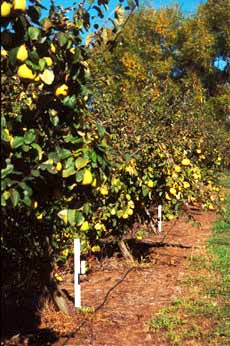
The common quince (Cydonia oblonga), originally from Asia, is grown commercially in small quantities in Australia. It grows in cooler subtropical areas to cold temperate regions, and has a culture similar to that of apples and pears.
Fifteen varieties have been grown at Orange Agricultural Institute. Harvesting ranges from mid-February in warmer areas with the very early Missouri Mammoth, to late April in cooler districts with the Van Deman.
Because of small production, the amount of fruit reaching the fresh fruit market can sell at attractive prices. There are difficulties, however, in producing high quality fruit.
The fruit is used fresh, stewed, preserved or made into jams and jellies. Most varieties cook up to an attractive pink colour but sometimes the pink colour can be very pale or even yellow (see Table 1). All quince jellies are a rich pink colour.
Climate
The quince is very adaptable. It grows well in a range of conditions, from the cooler parts of subtropical regions to cool temperate regions.
Coastal, tablelands and inland districts of New South Wales can produce good quinces. However, a disease called ‘fleck’ becomes more of a problem under moist coastal conditions. The tree needs some winter chilling for good fruit production. Under dry, warm to hot inland conditions, irrigation will be required to produce good crops.
Soils
Most soils are satisfactory except those that are light, shallow and likely to dry out. Heavy, moist soils are particularly good—well-grown fruit is often seen on trees growing wild near creek banks where this type of soil is often found. Established trees can withstand periods of very wet conditions, but this does not mean that quinces like poorly drained situations.
Quinces are particularly susceptible to iron deficiency under alkaline conditions; hence they prefer slightly acid soils.
Site
There are four important factors to be taken into account:
1. Aspect
Although successful plantings have been made on hillsides exposed to the south, avoid this aspect if possible. In early spring, these sites often experience cold southerly airstreams which, although perhaps not damaging in themselves, frequently create conditions too cold for the adequate movement of pollinating insects during the blossoming period.
2. Slope
Changed cultural techniques now permit the use of slopes that once would have been regarded as too steep. In practice, the degree of the slope that can be planted is dependent upon safe and efficient use of machinery.
3. Frost
Low air temperatures often occur in highland districts and can cause crop loss or damage from just before to just after the blossom period. This can be severe in poorly situated plantings. Valley floors, unless they have sufficient slope and are unobstructed by dense timber, are usually hazardous situations. Also, the lower parts of slopes are generally hazardous unless there is enough downside for air drainage.
Frost pockets should not be planted with any of the deciduous fruits. Quinces are the last of the deciduous fruits to flower; therefore a late frost can still damage the flower.
4. Wind
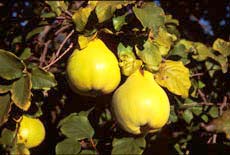
Excessive wind makes tree training more difficult, hinders tree development and can be very damaging to crops. Quinces in particular are susceptible to damage due to the floppy growth habit when fruit is on the tree. The site and general topography determine the need for windbreaks. If possible, establish windbreak trees before the orchard is planted, and promote development by the control of weeds and provision of irrigation. Alternatively, an artificial windbreak can be considered.
Propagation
Quinces will usually propagate readily from hardwood cuttings of selected varieties, although cuttings from some varieties will not root easily (e.g. Champion). The cuttings should be about 25 cm long and taken during the late autumn–early winter period (no later than the end of June). This is the most convenient method of propagation, butthe disadvantage is that resultant trees tend to produce suckers, which need to be periodically removed.
The Angers clonal quince selection, Quince A, can be used as a rootstock for the various quince varieties. By budding the selected varieties onto this rootstock, the treeswill bear a little earlier after planting out and, when fully grown, will be smaller than those established on their own roots or seedling rootstocks.
Quince seedlings are satisfactory as rootstocks for budding and have the advantage that such trees produced do not sucker. Where seedlings are to be used, the quince seed is extracted from mature fruit, cleaned, stratified in sand and stored in a cool place or held moist in a plastic bag in the refrigerator until planting out in late winter - early spring. If the seedlings are well grown, they will be large enough to bud with the desired varieties during the following late summer–autumn.
Trees on seedling rootstock should produce some fruit by about the fifth year. Those from cuttings will fruit sooner.
Orchard establishment
Trees establish better in virgin ground. Occasionally problems are encountered in virgin land where tree roots have become infected by the fungus Armillaria mellea,which is found on the roots of some native timbers. To minimise losses from this disease, roots from cleared timber must be grubbed and burnt. Deep-ripping of the site not onlybrings these roots to the surface to be collected and burnt, but promotes better tree growth during the early years of establishment.
With previously cropped land, as in the case of cleared land, try to improve soil fertility and ensure that soil pH is satisfactory.
Nurseries are often unable to provide trees at short notice, so it is wise to plan ahead and order in advance.
Pollination
There is no local evidence that quinces require pollen from another variety to set crops. Indeed, there are plenty of examples of single trees cropping well without pollinators. However, cropping improves in many deciduous fruit crops where pollination is provided. It is therefore suggested that more than one variety be grown if possible.
Flowers develop on new shoots in spring. The cultivars overlap fairly well in flowering from the earliest to the latest in cool districts. They open after most apple cultivars, with full bloom 4–7 days later than ‘Delicious’ apples.
Planting
Planting is best done during the latter part of June or early July when trees are completely dormant. Planting techniques and post-planting care are the same as for most other deciduous fruit trees.
A suggested planting distance is 5 × 2.5–3 metres, which will require some 667–800 trees per hectare. Where seedling rootstock has been used, especially wheresoils are deep and fertile, the trees can be expected to grow larger and a planting distance of 6 × 4.5 metres should be used, giving about 370 trees per hectare.
All quince varieties have a sensitive skin and are liable to superficial blemishes, especially if grown unprotected from wind.
Management of newly planted trees
Young trees need protection from vermin. Fences are equally effective, but sometimes stem guards or repellents are equally effective. Never allow grazing stock into youngplantations.
Control of grass and weeds around young trees is important and can be achieved with suitable herbicides. It may be necessary to protect the stems. If suckers develop, theymust be removed.
The young tree with restricted root development is particularly prone to long dry periods. Aim to have soil moisture available to meet requirements during the entire growing season to maximise early tree growth development and, later on, production.
Normally, pesticide applications to young trees are restricted in the interest of economy, but in order to do this effectively keep young plantings under regular observation (in particular observe for quince fleck, and pear and cherry slugworm).
Varieties
Fifteen varieties have been grown and examined by I&I NSW. These are described in Table 1.
| Variety | Flowering | Maturity | Size, shape and quality | Colour on cooking |
|---|---|---|---|---|
| Missouri Mammoth | Early | Early | Large, round | Pale pink |
| Portugal | Early mid | Early mid | Medium, pear-shaped, poor quality (small fruit strain) | Pale pink |
| Powell’s Prize | Early mid | Early mid | Small, pear-shaped | Pink |
| De Vranja | Early mid | Early mid | Large, long pear-shaped, good quality | Pink |
| Appleshaped | Mid late | Mid | Medium, short pear-shaped, good quality | Yellowish |
| Champion | Early mid | Mid | Medium, pear-shaped, good quality | Pale pink |
| Orange | Early | Mid | Small-medium, pear-shaped, poor quality | Pink |
| Rea’s Mammoth | Early mid | Mid | Large, short pear-shaped | Pink |
| Smyrna | Mid | Mid | Large, long pear-shaped, good quality | Pale pink |
| Mummery’s Seedling | Early | Mid late | Large, pear-shaped, good quality | Pale pink |
| Fuller’s | Early | Mid late | Medium-large, pear-shaped | Pale pink |
| Pineapple | Late | Mid late | Medium, pear-shaped, good quality | Pale pink |
| Master’s Early | Early | Late | Medium-large, pear-shaped | Pink |
| De Bourgeaut | Late | Late | Medium large, pear-shaped | Deep pink |
| Van Deman | Early | Very late | Medium, pear-shaped | Orange |
Figures 3 and 4 below show the comparative size and shape of some quince varieties.
Training and pruning
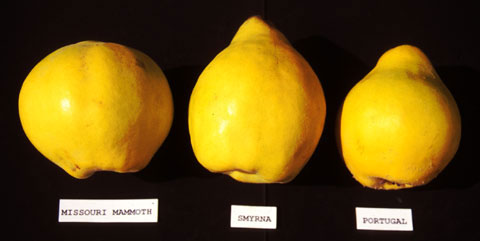
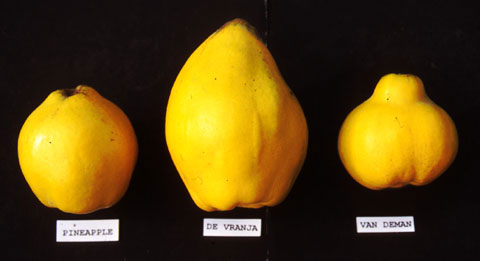
Quince trees are usually developed as vase or open-centred trees. Once the framework has been developed the tree must be pruned regularly, particularly the inner parts, whichcan become choked and shaded unless excessive growth is removed. Those limbs or the parts which are weak or crowded should be thinned, and the dead ones removed. Prune out unwanted shoots by removing them completely, not just shortening them, so as to encourage new growth for the future. Apart from this, little other pruning is required; however, if trees become too high, the tops can be shortened.
All pruning is normally done in the winter, and certainly any moderate or hard cutting should be confined to this period.
Unlike other pome fruit (apples and pears), it is difficult to train quince trees to have central leaders. This is because the fruits are often on the tips of shoots, causing the shoots to bend over, resulting in a floppy drooping tree habit. Also, the quince, unlike most deciduous fruits, produces its flowers and fruit on fairly short shoots which are produced during the same season. It is important to have plenty of new young wood each year, which should not be pruned back hard.
Soil management and irrigation
Controlled ground cover helps to increase productivity, and many growers have adopted sod culture, involving mowing, similar to that for apple and pear growing. Subterraneanclover and/or white clover are often included in the sod to increase soil fertility. Undisturbed sod has allowed the extension of plantings on slopes too steep to cultivate, and the sod will also support heavy equipment under wet conditions.
To control ground cover along the tree row, selected herbicides can be used or the tree row can be mulched, with the alleys being mowed. If using cultivation, as in drier areas,this should be shallow, as many of the roots are near the surface.
The availability of irrigation, even in high-rainfall districts, is essential to maximise early tree development, obtain early, heavy crops, achieve consistent cropping and produce fruit of optimum size. Irrigation should also be available from the start of the first growing season, or as supplementary irrigation in dry periods. Application of sufficient water throughout the season is necessary to maintain steady fruit growth.
Nutrition
Nutritional needs will vary according to soil fertility, tree age, density and productivity. Leaf colour, growth and productivity are the best guides.
As a rule, mixed fertilisers are best. Select one that has a nitrogen (N) content higher than that of phosphorus (P) and potassium (K). Apply a selected mixture to give about 350 g N annually to each tree of full bearing capacity.
Some growers apply a heavy application of nitrogenous fertiliser only in the spring, supplying up to 450 g N for each mature tree. Such a program would be supplemented by an application in the autumn of 50–100 kg P/ha (as 0.5–1 tonne single superphosphate per hectare); this will directly encouragegrowth of clovers, trefoils and other useful species for ultimate improvement of ‘soil organic matter’ status.
Yields
Mature plantings with about 250 trees per hectare have yielded about 25–35 tonnes fruit per hectare. In new plantings, where a greater number of trees are now planted perhectare than in the past, yields per tree may be less but the total yield per hectare will be greater.
Home growers with single trees can expect yields of 100–150 kg per tree. Expected yields vary according to the variety, as shown in Table 2.
| Heavy cropping | Medium cropping | Light cropping |
|---|---|---|
| Appleshaped | De Vranja | De Bourgeaut |
| Champion | Mummery’s Seedling | Missouri Mammoth |
| Fuller’s | Powell’s Prize | Portugal |
| Master’s Early | Rea’s Mammoth | Smyrna |
| Orange | Van Deman | |
| Pineapple |
Pests and diseases
ALWAYS READ THE LABEL
Users of agricultural (or veterinary) chemical products must always read the label and any Permit before using the product, and strictly comply with the directions on the label and the conditions of any Permit. Users are not absolved from compliance with the directions on the label or the conditions of the Permit by reason of any statement made or not made in this publication.
Fleck
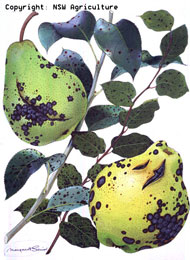
The only disease of consequence is fleck (Fabraea maculata) (pictured right), which occurs throughout New South Wales. Its effects can be serious. In coastal and tableland areas, fleck may defoliate quince trees if uncontrolled from January onwards. With severe infections, no marketable fruit develops.
Leaf infection may occur soon after leaf buds burst. The spots are very small, slightly raised and purple with a small central white dot. Spots may remain circular, or they mayenlarge and change colour to dark brown, then ashy grey or reddish-brown. They join together to form large irregular areas which may cover most of the leaf surface. By this stage, leaf stalks can be fatally affected and the leaves fall.
Dark brown spots develop on the skin of the fruit, which enlarge and become black and slightly sunken. With heavy infections, spots may join to form large, irregular areas,which cause fruit to be misshapen and often cracked. The disease may also cause fruit to fall prematurely.
Shoots develop inconspicuous lesions, which can enable the disease to carry over between seasons.
Quince varieties exhibit a range of susceptibility to fleck, as described in Table 3.
| Susceptible | Moderately susceptible | Moderately resistant | Resistant |
|---|---|---|---|
| Orange | Champion | Appleshaped | De Vranja |
| Powell’s Prize | Fuller’s | De Bourgeaut | |
| Missouri Mammoth | Master’s Early | ||
| Pineapple | Mummery’s Seedling | ||
| Portugal | Smyrna | ||
| Rea’s Mammoth | |||
| Van Deman |
Fleck can be controlled in home garden trees by raking and burning all fallen leaves in autumn. Prune regularly, and heavily enough to remove all dead and spent wood. The best way to overcome problems with fleck is to either choose moderately resistant varieties for humid climates, or use fungicides (see the Orchard Plant Protection guide—contact your local DPI office).
Fruit fly and codling moth
Fruit fly and codling moth are the main pests—these can be controlled through recommended pest control strategies for apples and pears as outlined in the Orchard Plant Protection Guide (contact your local NSW DPI office).
Pear and cherry slugworm
Pear and cherry slugworm (Caliroa cerasi) can cause a problem on the leaves. (See the Orchard Plant Protection Guide—contact your local NSW DPI office.)
Harvesting and marketing
With most varieties, as the fruit approaches maturity, the deep green of immaturity gradually lightens and passes through various colour changes until the yellow gold of full maturity is reached.
Despite its apparent firmness, the fruit will bruise and the skin will easily become marked by handling. Ideally, fruit for the fresh market should be harvested and handled when some colour signalling approaching maturity is apparent, but before it is fully mature. Because of the limited fresh fruit market for quinces, some of the larger growers begin marketing as soon as the fruit is fully developed but still fairly green. This extends the marketing period.
By growing a range of varieties with differing maturity dates, the harvesting period may extend over a period of 2 months. See Table 1 for details of the maturity range and flowering times.
In warm to hot districts, harvesting may commence as early as mid-February extending to April. On the cooler tablelands, fruit is usually not ready until towards the end of March.
When picking, long pieces of stem should be removed so that they will not cause skin damage to other fruits.
Storage
Although storage trials have not been conducted in New South Wales, Department experience has shown that a number of varieties can be successfully cool stored for a period of 2 months at a temperature of 0°–1°C (the temperature used for cool storing apples). Some varieties can develop superficial scald and flesh browning when in cool storage.
Quinces have a distinctive fruity odour, especially when confined in a storage chamber. Storing with other fruits may lead to problems of flavour tainting—enclosing the stored quinces in suitable polyethylene can usually overcome this problem. Obviously a cautious approach to storage is required at this stage.
Packing
For fresh fruit markets, the smaller sizes of quinces can be packed in the fibreboard carton, but larger sized fruit will not fit in a traypack; these can be fitted in a single-layer tray. Care must be taken when loose filling.
Reference
Baxter, Paul (1997), Growing Fruit in Australia, 5th edn, Thomas Nelson Australia, Melbourne, pp. 134–5.

